Learning how to make magenta acrylic paint mixes is a handy trick to have up your sleeve, especially since it’s such a useful color.
Recently, I’ve started running low on my beloved Quinacridone Magenta and am dealing with supply issues so why not take this opportunity to do a bit of experimenting?
Playing with paint is one of my most favorite things to do and it’s super helpful at teaching you how to come up with custom colors.
Having your own “recipe book” filled with unique paint colors can potentially save you a pretty penny. Plus, it’s fun when someone asks “what color did you use for that” and you get total bragging rights to say “Oh, that’s a custom color I designed”.
So, let’s just dive right into the world of magenta and find out what freakiness with can come up with!
In This Article...
- What Is Magenta Anyway?
- What’s The Difference Between Magenta And Fuchsia?
- Playing With Paint: How To Make Magenta
- How To Darken And Lighten Magenta
- How To Make A Bright Magenta
- Paint Substitutions For Magenta
- Best Painting Elements For Magenta Paint
- Choosing A Magenta Color Palette
- Final Word On Magnificent Magenta
What Is Magenta Anyway?
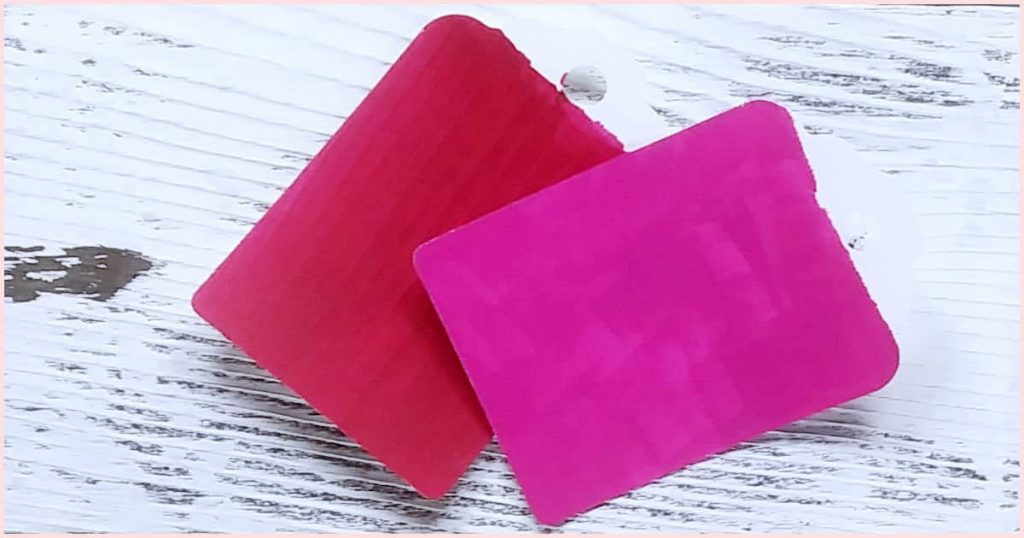
Before we get to experiment, we’ve got to be able to distinguish what colors are put together to create magenta.
Magenta is described as a purplish red, a reddish purple, a pinkie purple, and a bunch of other wishy-washy terms.
However, one thing is for sure magenta is a cool color. Therefore, for the sake of this experiment, we’ll say that magenta is a mix of a cool transparent red with a tiny bit of a cool transparent purple added.
What’s The Difference Between Magenta And Fuchsia?
Who would’ve thought there would be so much controversy over colors! But the question of whether Magenta and Fuchsia are the same hue is right up there with what came first, the chicken or the egg!
In some circles, magenta and fuchsia are the exact same color but in other circles magenta is seen as a reddish-purple that leans more toward red where fuchsia is also a reddish-purple, but it leans more toward purple. Some people say that fuchsia is nothing more than a plant with magenta flowers and not a color at all.
So, here’s the thing; tomato, tomahto, right? Let’s just leave it at that and move on to the good stuff.
Playing With Paint: How To Make Magenta
The purpose of this experiment was to see if I could create a passable substitute for Quinacridone Magenta. However, I also wanted to see if I could make anything close to a magenta color.
For the main experiment I wanted to see:
- Is it better to start with purple or blue to mix with the different reds?
- Does it matter what undertone the red has?
- Does it matter what undertone the blue has?
- Does adding yellow really help to lighten magenta (I’ve seen this statement floating around the web many times)?
- Is there any color combo that could serve as a sub for Quinacridone Magenta?
As always, I conduct these experiments in a way that will show you both the good and the bad. I know from experience that you learn just as much from the things that don’t work as you do from the things that do.
I also did a side experiment where I took the winning paint combo and played around with the ratios a bit to see how close I could get it to Quinacridone Magenta. Not only was I looking at the actual color but also transparency.
Lastly, I looked at paint colors that were recommended to lighten and darken magenta. These colors were mentioned numerous times around the web and I thought it would be interesting to put these claims to the test.
Paint Colors Used For Experiment
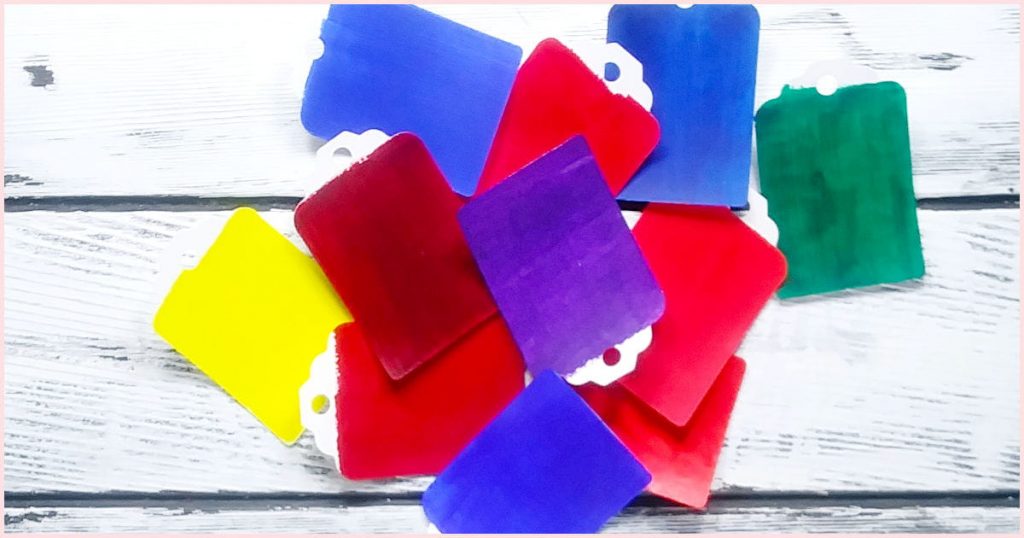
- Diox Purple (Liquitex Basics)
- Cadmium Red Medium Hue (Liquitex Basics)
- Cadmium Red Deep Hue (Liquitex Basics)
- Alizarin Crimson (Liquitex Professional)
- Rose Madder (Arteza Premium)
- Brilliant Red (Arteza Premium)
- Ultramarine Blue (Liquitex Basics)
- Cobalt Blue (Liquitex Basics)
- Phthalo Blue (Liquitex Basics)
- Phthalo Green (Liquitex Basics)
- Lemon Yellow (Arteza Premium)
- Titanium White (Winsor & Newton Galeria)
- Unbleached Titanium (Liquitex Basics)
- Black Iron Oxide (Mars Black) (Stevenson)
- Quinacridone Magenta (Liquitex Basics)
- Magenta Light (Arteza Premium)
Remember, if you use different brands than the ones shown you may end up with different results. This is why switching directly from one brand to another can lead to disaster. Not all brands use the same pigment sourced from the same place so you may find that paint colors can vary.
Details Of The Main Experiment
In my quest to learn how to make magenta paint for myself, I decided to keep it real simple.
At the very top of the page I made color swatches of Quinacridone Magenta (Liquitex Basics) and Magenta Light (Arteza Premium) and then mixed both with some Titanium White.
Although my main goal was to find a match for Quinacridone I thought I’d also include Magenta Light just to see if I could find a close dupe for that as well.
You’ll see that each column is listed as a different red paint color. For the rows, I started with the base mixture of either red and purple or red and blue. In the next row I lightened each color with Titanium White and, lastly, I add Lemon Yellow to the previously lightened mixture.
This was done so that you could see the color a bit better and to also answer the question of “can you use yellow to lighten magenta?”
Each color mixture was created with the same ratios; 2 parts red to 1 part blue or purple.
I’ll get into the details of the side experiments a bit later.
How To Make Magenta: The Results
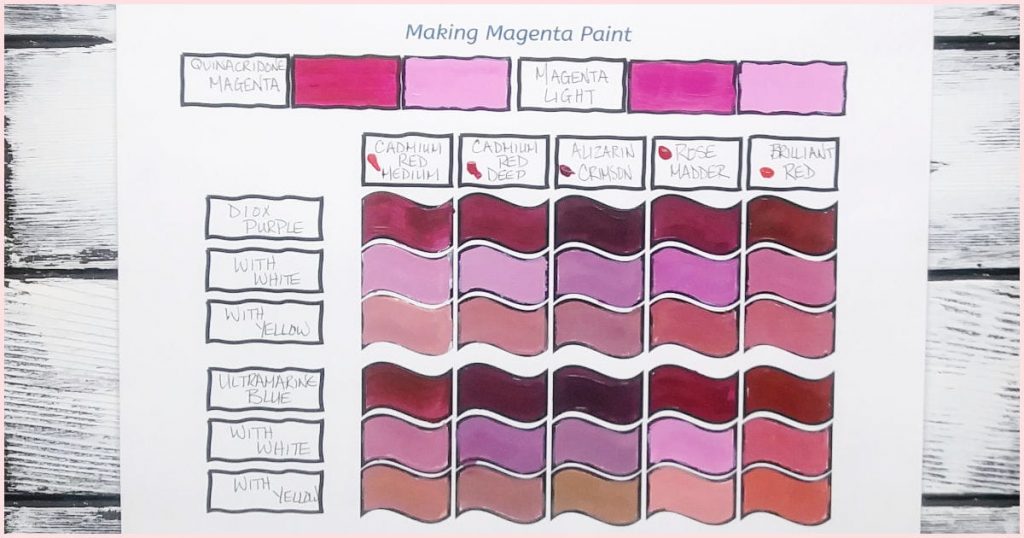
Row Headings (1st Set): Diox Purple, mixed with Titanium White, then Diox Purple/Titanium White mixture with Lemon Yellow added
Row Headings (2nd Set): Ultramarine Blue, mixed with Titanium White, then Ultramarine Blue/Titanium White mixture with Lemon Yellow added
Again, all paint mixtures are 2:1. So, 2 parts red and 1 part Diox Purple or Ultramarine Blue.
What’s a part you ask? A part is any measurement. So, let’s say I use one squish of paint as a part. That would mean that I would use 2 squishes of red to 1 squish of purple or blue. It’s not an exact science but it’s good enough for the purposes of finding new paint colors.
Biggest Observations:
- The closest to magenta is Ultramarine Blue and Rose Madder
- Most color mixes turned out to be a wine or burgundy
- Adding yellow to the base mixtures with white was more likely to make a brown or a dulled down version of the base plus white
- Adding white to the base mixture created mostly mauves or purply pinks
- There were no exact dupes for Quinacridone Magenta in this group
Originally, I was just intending to stick with Diox Purple and Ultramarine Blue. However, a quick Google search of cool vs. warm blue paint colors convinced me to add a couple more colors.
I found some pretty serious discrepancies out there regarding undertones and how to tell if a blue is cool or warm.
Some were saying that if your blue leaned more toward green, it was cool and others were saying that if it leaned more toward purple it was cool.
This just proves how easy it is to become confused about the color wheel so if you’re looking for some guidance, check out my article that gives you the basics on color theory.
I’m so glad I decided to add Phthalo Blue and Cobalt Blue to the color roster. This led to some interesting discoveries that I think might be quite helpful to you.
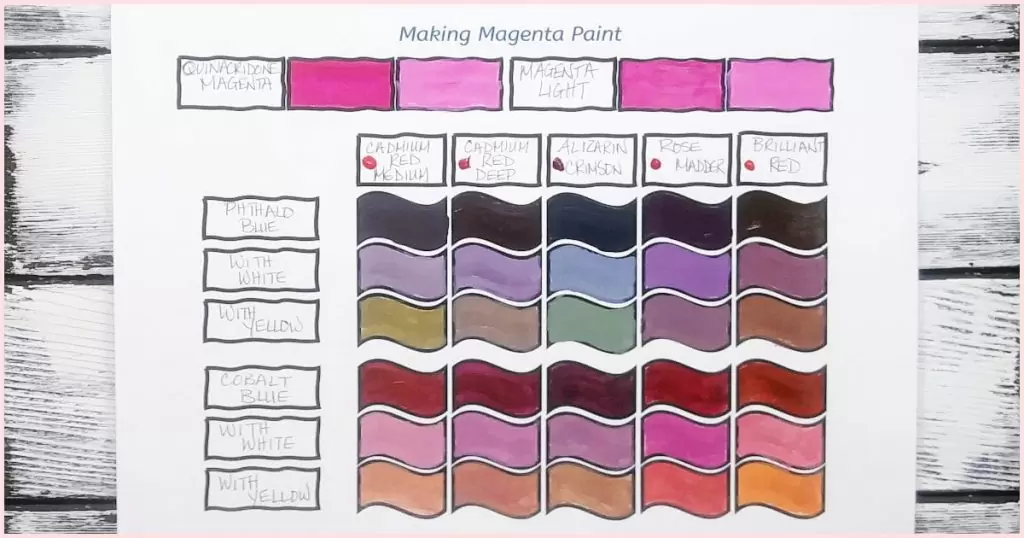
Row Headings (1st Set): Phthalo Blue, Phthalo Blue mixed with Titanium White, Phthalo Blue/Titanium White mixture with Lemon Yellow added in
Row Headings (2nd Set): Cobalt Blue, Cobalt Blue mixed with Titanium White, Cobalt Blue/Titanium White mixture with Lemon Yellow added
Interesting Takeaways:
- Phthalo Blue is a strong pigment so you definitely want to use less than one part to two parts red (I would actually add this color very slowly and mix well until you reach the desired hue)
- Phthalo Blue and Alizarin Crimson make….. navy blue??? Cool! I’ll have to remember to add this recipe mixture to my article where I experiment with making navy blue paint
- Brilliant Red + Cobalt Blue + Titanium White + Lemon Yellow make the most beautiful tangerine color!
- The closest dupe for Quinacridone Magenta is Cobalt Blue and Rose Madder
Overall, we’ve learned a few things here; Phthalo blue is a warm blue because it leans toward green whereas Ultramarine Blue and Cobalt Blue are more cool because they lean toward purple.
Both your blue base color and your red need to have a cool undertone, so choose purplish blues and berry reds.
In addition, both the blue and the red you choose to use should be bright and vibrant. If either is too dark, you won’t be able to create magenta.
How To Darken And Lighten Magenta
We wouldn’t fully be learning how to make magenta paint without knowing how to darken and lighten it.
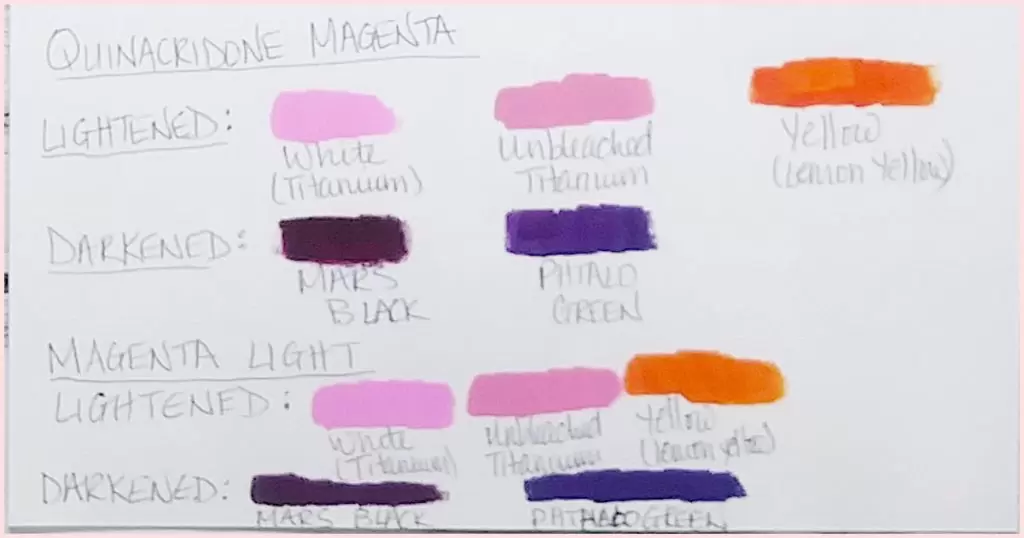
Second Row: Quinacridone Magenta darkened with Mars Black and Phthalo Green
Third Row: Magenta Light lightened with Titanium White, Unbleached Titanium, and Lemon Yellow
Fourth Row: Magenta Light darkened with Mars Black and Phthalo Green
Note: Please forgive the blurriness in the photo. I’m a painter, but obviously, not a photographer, haha!
When it comes to lightening magenta, you can use Titanium White. This is the preferred option if you want to keep the vibrancy of the magenta.
If you’d rather tone down the magenta a bit, while lightening it, try Unbleached Titanium. Unbleached Titanium has a creamy, slightly yellow, undertone.
But what about this talk about using yellow to lighten magenta? As you can see in the photo above, yes you can lighten magenta with yellow but it totally changes the color so it’s not magenta anymore. I would not recommend using yellow to lighten magenta but I would recommend pairing it with magenta to create fabulous sunsets!
When it comes to darkening magenta, obviously you can use a bit of black to gradually darken magenta. You will end up with a deep rich Bordeaux red.
Another option is to work with a cool green. Green is the complementary color to red, and since magenta is more red/pink than purple, green will turn it into a lovely shade of ….. wait for it ….. a shade that is suspiciously close to ….. Diox Purple! Maybe not the dupe we were looking for but, hey, any sub we can find is always welcome, am I right?
How To Make A Bright Magenta
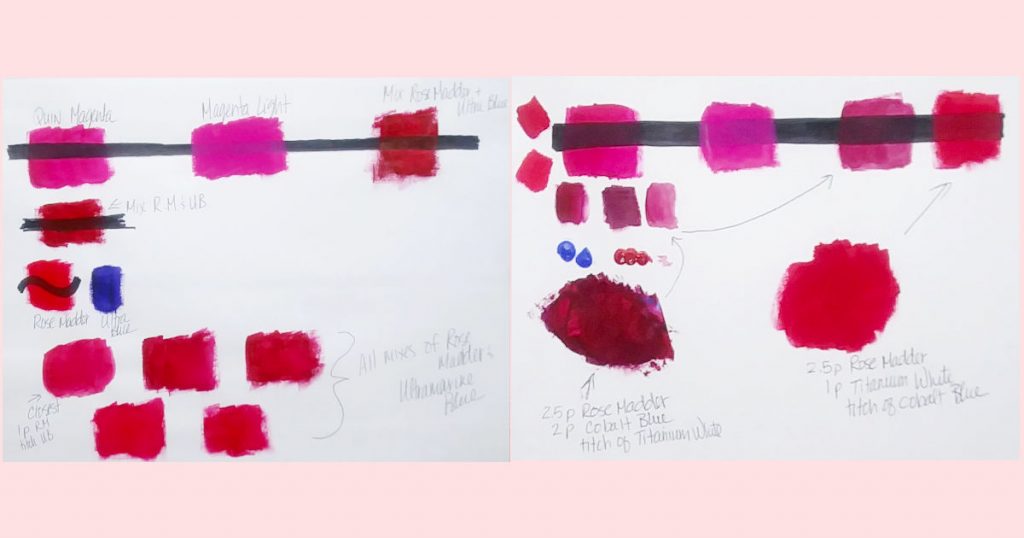
Right: All mixtures are made from mixing Rose Madder and Cobalt Blue. Out of these swatches, the winning combo is 2.5 parts Rose Madder to one part Titanium White and a “titch” of Cobalt Blue.
In the blurry image above (sorry!), I took the winning combos, Rose Madder mixed with Ultramarine Blue and Rose Madder mixed with Cobalt Blue, from the main experiment and played around with them a bit more (what can I say, I love squishing paint!). The goal of this side quest was to create a color that was close to Quinacridone Magenta.
Quinacridone Magenta is a transparent color that is very cool and bright. It is straight up one of my faves and I use it in a lot of my own work.
What I learned is that you only need the smallest bit of blue added to Rose Madder to create a decent substitute for Quinacridone Magenta.
Additionally, Rose Madder is also a very transparent paint color and that plays in our favor when trying to dupe Quinacridone Magenta.
You also want to be stingy with the Titanium White when adding it to try to brighten the mixture. Too much white and you’ll lose the transparency so it’s smart to avoid it if possible.
Paint Substitutions For Magenta
So, what if you don’t have time to learn how to make magenta paint and you just want to know what other paint pigments would work as a sub?
Well, you have a couple of options, but you’ll still have to do a bit of mixing.
The two most popular recommendations to use as subs for Quinacridone Magenta are Quinacridone Violet, with a bit of red added, or Permanent Rose, with a bit of blue added. However, if you happen to have a tube of Arteza Premium Rose Madder, just play around with it. I find it’s a nice cool red that borders on pink which is a great starting point.
Best Painting Elements For Magenta Paint
Quinacridone Magenta is such a beautiful color and one that is very useful. I actually didn’t realize just how often I use it until I started organizing my notes for this article. Let’s just say that there aren’t many paintings that I’ve done that don’t have magenta in them!
Some of the painting subjects I consistently use Quinacridone Magenta for are:
- Sunsets (with either Cadmium Yellow Medium or Indian Yellow)
- Sunrises (with a more pale yellow)
- Flowers (roses, magnolias, hydrangeas, etc.)
- Backgrounds (take a look at my tulip tutorial to see what happens when you mix Quinacridone Magenta with Indian Yellow)
There’s more but these are the paintings where my go to is Quinacridone Magenta. It totally makes sense to learn how to make magenta paint when you use it as often as I do.
Choosing A Magenta Color Palette
Magenta is quite a bold color so it can sometimes feel a bit overwhelming to figure out what other colors to use along with it.
Some popular color combinations that include magenta are:
- Other pinks
- Shades of brown and taupe
- Bright or pale yellow
- Soft or bright lime green
- Pale mauve
- Pale dusty blue
If you need a visual, Color Palettes has a great selection of bright magenta color palettes with coordinating pictures.
Final Word On Magnificent Magenta
Not only did we learn how to make magenta (or at least a close version), we talked about the best uses for the paint color, and which other hues look good with it. We’ve also found some more paint recipes to add to our paint mixing journals!
In the end, would I ever consider switching from Quinacridone Magenta straight out of the tube and start making my own version? No. I love Quinacridone Magenta way too much to let it go. It will forever be in my top five paint colors to own.
However, now that I know how to make magenta, I won’t have to freak out if I run out of the real thing. I can quickly make up my own and continue with my work in progress until I get the chance to purchase more.
If you found this article helpful, share it with your paint pals!
Interested In Learning How To Mix Other Paint Colors?

Meet Sara, a seasoned veteran in the world of art. With a knack for mixing paints to unveil breathtaking new hues, she’s adorned countless commissions and independently captivated art enthusiasts with her creations. Having spent over a decade immersed in the realm of art gallery management, Sara’s insight into the intricacies of the art scene shines through her work.
But don’t let her impressive résumé fool you – Sara’s approach to art is as lively as her palette. Known for her wit and humor, she infuses her passion for painting with a playful spirit, making every stroke a delightful adventure. As a dedicated mentor, she’s committed to guiding her fellow artists towards success, always staying ahead of the curve with the latest techniques and trends.
